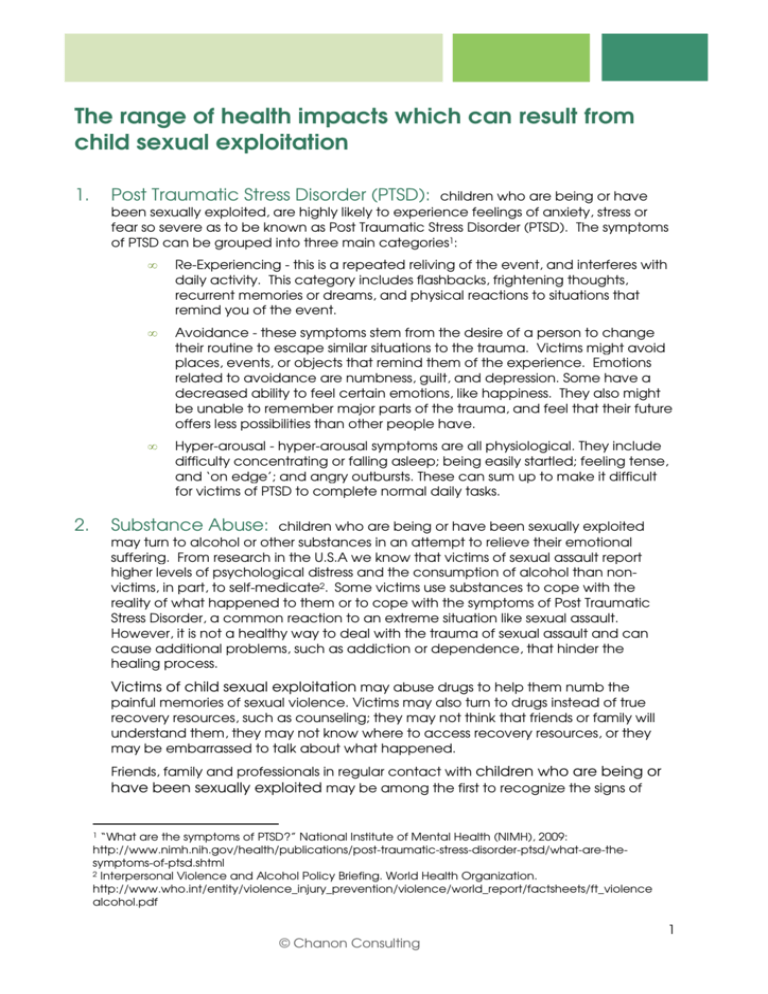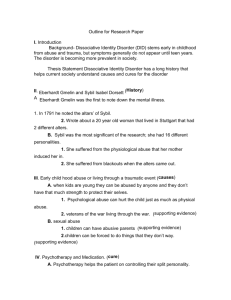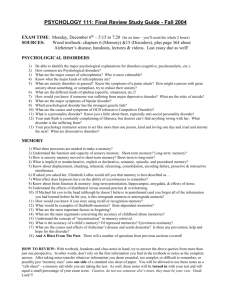
The range of health impacts which can result from
child sexual exploitation
1.
2.
Post Traumatic Stress Disorder (PTSD):
children who are being or have
been sexually exploited, are highly likely to experience feelings of anxiety, stress or
fear so severe as to be known as Post Traumatic Stress Disorder (PTSD). The symptoms
of PTSD can be grouped into three main categories1:
•
Re-Experiencing - this is a repeated reliving of the event, and interferes with
daily activity. This category includes flashbacks, frightening thoughts,
recurrent memories or dreams, and physical reactions to situations that
remind you of the event.
•
Avoidance - these symptoms stem from the desire of a person to change
their routine to escape similar situations to the trauma. Victims might avoid
places, events, or objects that remind them of the experience. Emotions
related to avoidance are numbness, guilt, and depression. Some have a
decreased ability to feel certain emotions, like happiness. They also might
be unable to remember major parts of the trauma, and feel that their future
offers less possibilities than other people have.
•
Hyper-arousal - hyper-arousal symptoms are all physiological. They include
difficulty concentrating or falling asleep; being easily startled; feeling tense,
and ‘on edge’; and angry outbursts. These can sum up to make it difficult
for victims of PTSD to complete normal daily tasks.
Substance Abuse: children who are being or have been sexually exploited
may turn to alcohol or other substances in an attempt to relieve their emotional
suffering. From research in the U.S.A we know that victims of sexual assault report
higher levels of psychological distress and the consumption of alcohol than nonvictims, in part, to self-medicate2. Some victims use substances to cope with the
reality of what happened to them or to cope with the symptoms of Post Traumatic
Stress Disorder, a common reaction to an extreme situation like sexual assault.
However, it is not a healthy way to deal with the trauma of sexual assault and can
cause additional problems, such as addiction or dependence, that hinder the
healing process.
Victims of child sexual exploitation may abuse drugs to help them numb the
painful memories of sexual violence. Victims may also turn to drugs instead of true
recovery resources, such as counseling; they may not think that friends or family will
understand them, they may not know where to access recovery resources, or they
may be embarrassed to talk about what happened.
Friends, family and professionals in regular contact with children who are being or
have been sexually exploited may be among the first to recognize the signs of
1 “What are the symptoms of PTSD?” National Institute of Mental Health (NIMH), 2009:
http://www.nimh.nih.gov/health/publications/post-traumatic-stress-disorder-ptsd/what-are-thesymptoms-of-ptsd.shtml
2 Interpersonal Violence and Alcohol Policy Briefing. World Health Organization.
http://www.who.int/entity/violence_injury_prevention/violence/world_report/factsheets/ft_violence
alcohol.pdf
1
© Chanon Consulting
substance abuse. Early recognition increases chances for successful treatment.
Warning signs include3:
•
•
•
•
•
•
•
•
•
•
•
Giving up past activities or hobbies
Spending time with new friends who may be a negative influence
Declining grades or performance at work
Aggressiveness, irritability
Forgetfulness
Disappearing money or valuables from family and friends
Lying
Depression or hopelessness
Avoiding friends and family
Drinking and driving or getting in trouble with the law
Suspension from school or work
When compared to non-victims, rape survivors are 3.4 times more likely to use
marijuana, 6 times more likely to use cocaine, and 10 times more likely to use other
major drugs.
3.
Self-Harm: the reasons why a victim of child sexual exploitation is vulnerable to
self-harm, or self-injury is because they experience self-harm as providing4:
•
•
•
•
•
•
•
A way to express difficult or hidden feelings. It’s common for victims to feel
numb or empty as a result of sexual assault
A temporary sense of feeling again, as well as a way to express anger,
sadness, grief or emotional pain.
A way of communicating to others that support is needed
A distraction from emotional pain
Self-punishment for what they believe they deserve
Proof that they are not invisible
A feeling of control: It’s not uncommon to feel that self-harm is the only way
to have a sense of control over life, feelings, body, especially if other things
in life are out of control
4.
Physical injury: sexual exploitation is sexual assault, and children who are being,
or have been sexually exploited, are likely to have genital and other injuries which
need expert medical identification and treatment. Physical injuries can include
contusions, lacerations, abdominal trauma , joint dislocation, mechanical back pain,
lesions caused by forceful genital penetration and , in relation to pregnancy placental abruption (with potentially very serious consequences for both mother and
baby.
5.
Denial of the abuse/defence of the abuser: there are two accepted
explanations of why a child or young person may defend the abuser and/or deny
that the relationship with the perpetrator is abusive.
a) According to the Stockholm Syndrome children who experience a perceived or
real threat to their physical or psychological survival and believe that the abuser
will carry out the threat - as is the case when they are being or have been
sexually exploited, can develop and retain an emotional ‘bonding’ with their
3
Mental Health: Substance Abuse. WebMD.com. 2009. http://www.webmd.com/mentalhealth/substance-abuse
4 Reach Out US. 2009. http://us.reachout.com/the_facts/dealing-with-suicide-self-harm/self-harm
2
© Chanon Consulting
abuser5. The positive feelings the child has for the abuser lead to the child
supporting or helping the abuser. At the same time the child develops negative
feelings toward family, friends, or authorities which creates isolation from other
perspectives. This exacerbates the child’s perception or real inability to escape
from the situation.
Stockholm Syndrome develops subconsciously and on an involuntary basis,
through several stages:
•
The victim dissociates from his or her pain, helplessness or terror by
subconsciously beginning to see the situation / world from the abuser’s
perspective. The victim begins to agree with the abuser and certain aspects
of his or her own personality, opinions, and views will fade into the
background
•
By doing this, the victim begins to learn how to appease and please the
abuser, which may keep him or her from being hurt or worse. Similarly this
tactic can be used to manipulate the abuser into being less dangerous, at
least for a little while
•
After a while the victim begins to realise that his or her abuser portrays the
same human characteristics as anyone else. At this point he or she will
begin to see the abuser as less of a threat. Some abusers may even share
personal information in an effort to bond with the victim and to promote
pity rather than anger
•
This bonding, in turn, leads to conflicting feelings (e.g., rage and pity) and
illogical concern for the abuser. The victim ignores his or her own needs
•
Once the traumatic event has ended, however, the victim must again learn
not to dissociate from his or her emotions and not focus on the abuser. This
can be a very difficult transition
The Stockholm Syndrome reaction may possibly be understood as a special kind
of betrayal trauma6
b) Betrayal Trauma Theory7 posits that whilst humans have evolved to be excellent
self-protective detectors of potential or actual betrayal, under some
circumstances detecting betrayal may be counter-productive to survival goals.
Thus in cases where the victim is, or perceives themselves to be, dependent on
the abuser, the victim to remains ‘unaware’ of the abuse in order to maintain the
relationship which s/he perceives as key to survival8. The theory accepts that the
knowledge/memory of the abuse enters the ‘system’, but that the victim isolates
or dissociates awareness from consciousness.
Betrayal theory gives three explanations for how the victim can be unaware of
the abuse:
i)
The neurobiological impact of fear, and the stress it causes, impairs the
hippocampus and related structures responsible for memory consolidation.
5 Love and Stockholm Syndrome: The Mystery of Loving an Abuser. Counseling Resource. Dr. Joseph M
Carver, PhD. January 2004
6 J.J. Freyd, What is a Betrayal Trauma? What is Betrayal Trauma Theory? 2012
http://pages.uoregon.edu/dynamic/jjf/defineBT.html.
7 J.J. Freyd, 1996
8 Shultz & colleagues, 2003; Freyd, De Prince and Zurbrigger, 2007; Edwards et al, 2001; Sheiman, 1999
3
© Chanon Consulting
Hippocampus dysfunction in an individual with PTSD is likely to explain
impaired ability to integrate memories for trauma at the point of retrieval9.
5.
ii)
Dual-representation theory recognises verbally accessible memories (VAM)
and situationally accessible memories (SAM)10. VAMs are linked to a
particular point in time, can be updated and are verbally accessible. SAMs
on the other hand, remain current and give rise to intrusive memories
(flashbacks) in which ‘one doesn’t know what happened in a verbally
accessible way’11.
iii)
Avoidance. To the extent that fear-related memories are painful and
aversive, anxiety models suggest that a sexually exploited child will
increasingly avoid both external and internal reminders of the trauma.
Particularly when these memories are prematurely inhibited, they may not
be processed in ways that integrate them into other autobiographical
memories, increasing the likelihood of unawareness12.
Depression:
this one of the most common emotional and psychological reactions
that children who are being or have been sexually exploited have. Symptoms
include13:
•
•
•
•
•
•
•
•
•
•
•
Prolonged sadness or unexplained crying spells
Change in appetite with significant weight loss (without dieting) or weight
gain
Loss of energy or persistent fatigue or lethargy
Significant change in sleep patterns (insomnia, sleeping too much, fitful
sleep, etc.)
Loss of interest and pleasure in activities previously enjoyed, social
withdrawal
Feelings of worthlessness, hopelessness, or inappropriate guilt
Foreshortening (“we are all going to die anyway”), pessimism or indifference
Unexplained aches and pains (headaches, stomachaches)
Inability to concentrate, indecisiveness
Irritability, worry, anger, agitation or anxiety
Recurring thoughts of death or suicide
6.
Sexually Transmitted Infections: children who are being, or have been
sexually exploited may have contracted on of the following infections, for which they
will need treatment: HIV/AIDS, Chlamydia, Crabs, Human Papilloma Virus (HPV or
genital warts), Herpes, Hepatitis B, Syphilis, Trichomonas. An expert medical opinion is
needed to identify and treat these infections because some of them can lead to very
serious complications. These range from problems in pregnancy, passing the infection
or disease on the baby, Pelvic Inflammatory Disease, cervical, penile and testicular
cancer, damage to the liver, heart, brain and/or spinal cord, immune system failure
and death.
7.
Pregnancy /termination:
young women who are being sexually exploited
may struggle to exercise birth control due to a chaotic lifestyle, forgetfulness,
9
Bremner, 2001
Brewin, 2003; Brewin, Dalglish & Joseph, 1996
11 Ibid
12 Ibid
13 American Psychiatric Association, Diagnostic and Statistical Manual of Mental Disorders: Text Revision,
fourth edition, 2000
10
4
© Chanon Consulting
depression, hopelessness, substance abuse or because the abuser is actively
sabotaging her birth control efforts.
Teenage mothers, particularly those who do not receive good support from their
family, are at risk of social isolation, poor life habits, low education attainment - which
limits their employment prospects, revictimisation, stress, and depression14.
Whilst for children or young women who choose to have a termination, the facts are:
•
They twice as likely as their peers to abuse substances15
8.
•
They are 6 times more likely to commit suicide in the six months after the
termination, than teenagers who have not had a termination16
•
They have greater difficulty coping after a termination than older women,
they are nearly three times more likely to be admitted to a mental health
facility than other teenagers17
•
Young women who report ‘being particularly fond of children’ do not do as
well psychologically after a termination18. Teenagers who have a
termination often have problems with sexuality and parenting in later life
•
They report having a termination as a lonely, traumatic experience and
associated with feelings of guilt, depression and a sense of isolation19
•
They are more likely to report severe nightmares and to score higher on
scales measuring antisocial traits, paranoia, substance abuse and psychotic
delusions than are older women who have had a termination20
•
They are likely to become pregnant again within the next few years21.
Among pregnant teenagers, those who have had a termination are at least
four times more likely to have another termination22
Flashbacks (re-experiencing): a flashback is when memories of past
traumatic events feel as if they are taking place in the current moment. Many
children who are being or have been sexually exploited experience these emotional
returns to the trauma, believing themselves to be back at the scene of the attack or
abuse. Flashbacks are also a symptom of PTSD.
According to the National Institute of Mental Health, “Flashbacks may consist of
images, sounds, smells, or feelings, and are often triggered by ordinary occurrences,
such as a door slamming or a car backfiring on the street. A person having a
14
Loignon, 1996
H. Armaro et al, Drug Use among adolescent mothers: profile of risk, Pediatrics, 84, 1089, 144-150
16 B. Garfinkel et al, Stress, Depression and Suicide: A Study of Adolescents in Minnesota. Responding to
High Risk Youth, University of Minnesota extension Service,1986
17 R. Somers, Risk of Admissions to Psychiatric Institutions among Danish Women who Experience
Induced Abortion: An Analysis based on national Report Linkage (Ph.D. Dissertation, Los Angeles:
University of California, 1979, Dissertation Abstracts International, Public Health 2621-B)
18 E.M. Smith, A follow-up study of women who request abortion, American Journal of Orthopsychiatry,
1973,43: 574-585
19 E. Biro et al, Acute and Long-Term Consequences for Adolescents who Choose Abortions, Pediatric
Annals 15(10) 667-672, 1986
20 N. Campbell et al, Abortion in Adolescents, Adolesence, 23:813-823, 1988
21 S.R. Wheeler, Adolescent pregnancy Loss, in J.R. Woods Jnr and J.L. Woods (eds); Loss During
Pregnancy or the Newborn period (1997); and H. Crejic et al, Follow-up of 50 adolescent girls 2 years
after abortion, Canadian Medical Association Journal, 116:44,1997
22 T. Joyce, The Social and Economic Correlates of pregnancy Resolution Among Adolescents in New
York by Race and Ethnicity: A Multivariance Analysis, American Journal of Public Health, 78(6):626, 1988
15
5
© Chanon Consulting
flashback may lose touch with reality and believe that the traumatic incident is
happening all over again"23.
Flashbacks can be triggered by many stimuli, such as sensory or emotional feelings. It
can sometimes feel as though flashbacks come from nowhere, making it difficult to
distinguish between past and present. They can often leave the survivor feeling
anxious, scared, powerless, as well as any other emotions they felt at the time of the
traumatic event24.
Some flashbacks are mild and brief, a passing moment, while others may be powerful
and last a long time. Many times the individual does not even realize that s/he is
having a flashback and may feel faint or dissociate.
9.
Borderline Personality Disorder:
Borderline Personality Disorder, known as
BPD, is one of many possible long-term effects of child sexual exploitation. Research
by the Psychiatric Clinics of North America indicates that 40-to71% of BPD victims
reported having been sexually abused when younger25. Adults with BPD are also
considerably more likely to be the victim of violence, including rape and other
crimes26. As defined by the National Institute of Mental Health, BPD “is a serious
mental illness characterized by pervasive instability in moods, interpersonal
relationships, self-image, and behavior. This instability often disrupts family and work
life, long-term planning, and the individual's sense of self-identity27.”
Diagnosis of BPD should be made only by a mental health professional. For someone
to be diagnosed with any personality disorder, the symptoms must be severe and
must go on long enough to cause significant emotional distress or problems
functioning in relationships or at work28.
While each individual's experiences and reactions are unique, there are some
common symptoms, including29:
•
•
•
•
•
•
•
•
Fear of abandonment
Dramatic and frequent mood swings
Depression or anxiety experienced in short bursts
Intense anger (sometimes escalating into physical confrontations)
Difficulty controlling emotions or impulses
Impulsive and risky behavior (e.g., substance abuse, unsafe sex, gambling,
erratic driving)
Self-harm
Suicidal thoughts and suicide (8-10% of patients with BPD commit suicide)30
23 “Anxiety Issues,” National Institute of Mental Health, November 2 2010
http://www.nimh.nih.gov/health/publications/anxiety-disorders/complete-index.shtml# pub4
24 What is a “Flashback?” Virginia Sexual and Domestic Violence Action Alliance, 2006.
http://www.vadv.org/Resources/flashbacks.html
25 Zanarini MC. Childhood experiences associated with the development of borderline personality
disorder. Psychiatric Clinics of North America, 2000; 23(1): 89-101
26 Borderline Personality Disorder,” National Institute of Mental Health, August 24, 2010:
http://www.nimh.nih.gov/health/publications/borderline-personality-disorder-fact-sheet/index.shtml
27 Borderline Personality Disorder,” National Institute of Mental Health, August 24, 2010:
http://www.nimh.nih.gov/health/publications/borderline-personality-disorder-fact-sheet/index.shtml
28 Borderline Personality Disorder,” Mayo Clinic, May 19 2010:
http://www.mayoclinic.com/health/borderline-personality-disorder/DS00442
29 Borderline Personality Disorder Symptoms, “ Mayo Clinic, May 19 2010:
http://www.mayoclinic.com/health/borderline-personality-disorder/DS00442/DSECTION=symptoms
30 Borderline Personality Disorder,” National Alliance on Mental Illness:
http://www.nami.org/Template.cfm?Section=By_Illness&Template=/TaggedPage/TaggedPageDisplay.
cfm&TPLID=54&ContentID=44780
6
© Chanon Consulting
•
Dysfunctional social relations
10. Sleep Disorders (nightmares, insomnia and Sleep Terror Disorder):
many children who are being or have been sexually exploited experience sleep
disturbances and disorders. In Sleep Terror Disorder, the young person experiences
repeated abrupt awakenings from sleep, usually beginning with a panicky scream or
cry. Whilst asleep the child is going through behavioral manifestations of intense fear
and is difficult to awaken or comfort. After finally waking, the individual has no
recollection of the event except perhaps a single image31. Lack of sleep
exacerbates the young person’s inability to cope with the circumstances they find
themselves in.
11. Eating Disorders (anorexia nervosa, binge eating and bulimia):
children who are being or have been sexually exploited can develop eating disorders
because self-starvation, bingeing, and purging may feel like a way to regain control
of a certain aspect of their lives. Factors stemming from sexual abuse that may result
in an eating disorder include32:
•
•
•
•
Low self-esteem
Feelings of inadequacy or lack of control in life
Depression, anxiety, anger or loneliness
Difficulty expressing (often overwhelming) emotions and feelings
But ultimately, the damage caused by eating disorders can worsen their physical and
emotional health as well as their self-esteem.
10. Somatic (Body) Memories:
somatic/body memories are when the stress of
the memories of the abuse experienced by an individual take the form of physical
problems that cannot be explained by the usual means (medical examinations, etc.).
These are often called ‘psychosomatic symptoms’ meaning that the symptoms are
due to the connection between the mind and the body. Physical problems that can
come of these somatic memories include headaches, migraines, stomach difficulties,
light headedness/dizziness, hot/cold flashes, grinding of teeth, sleep disorders, etc.
They are difficult to diagnose and cure and may add to the difficulties in recovery.
11. Dissociative Identity Disorder:
Dissociative Identity Disorder (DID), previously
referred to as multiple personality disorder (MPD), is a dissociative disorder in which
two or more separate and distinct identities (or personalities) control an individual's
behavior at different times. Dissociation is a mental process in which a person's
thoughts and feelings may be separated from his or her immediate reality.
Most mental health practitioners believe that dissociation exists on a continuum. At
one end of the continuum, are instances of dissociation that many people
experience such as daydreaming or highway hypnosis. At the other end, though, is
chronic and complex dissociation which may impair an individual's ability to function
in the ‘real’ world. Dissociative Identity Disorder (DID) is33:
a) The presence of two or more distinct identities or personality states (each
with its own relatively enduring pattern of perceiving, relating to, and
thinking about the environment and self)
31
Diagnostic and Statistical Manual of Mental Disorders. American Psychiatric Association. 2000
National Eating Disorders Association. 2009. http://www.nationaleatingdisorders.org/index.php
33 Diagnostic and Statistical Manual of Mental Disorders, Fourth Edition, Text Revision
32
7
© Chanon Consulting
b) At least two of these identities or personality states recurrently take control
of the person's behavior
c) Inability to recall important personal information that is too extensive to be
explained by ordinary forgetfulness
d) The disturbance is not due to the direct physiological effects of a substance
(e.g., blackouts or chaotic behavior during Alcohol Intoxication) or a
general medical condition (e.g., complex partial seizures)
While the causes of DID are not entirely known, it is believed that the disorder stems
from physical or sexual abuse in childhood. It is believed that children develop this
disorder when during abusive situations they slip into dissociative states in order to
remove themselves from the situation. If the abuse continues over time, it is believed
that children may then begin to split into alter identities during these times of
dissociation.
12. Suicide:
there is a heightened risk of suicide or attempted suicide from young
people who are being, or have been, sexually exploited. Factors which influence this
include depression, substance abuse, self-harming and ‘foreshortening’, in which a
young person’s view of their own future becomes passive, rigid and fatalistic (“we’re
all going to die anyway”)’.
8
© Chanon Consulting






